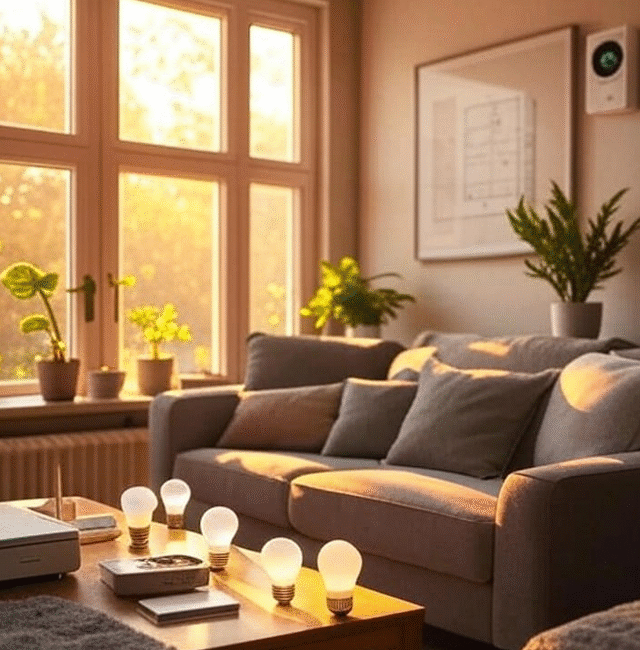In today’s world, managing energy use efficiently is not only good for the environment but also essential for reducing household expenses. With rising energy costs, finding practical ways to save energy and cut your bills can have a significant impact on your wallet and your carbon footprint. Fortunately, many of these strategies are simple to implement and require minimal investment. Here’s a comprehensive guide to help you start saving energy at home and watch your utility bills shrink.
1. Upgrade to Energy-Efficient Lighting
One of the easiest ways to reduce your energy consumption is by replacing traditional incandescent bulbs with energy-efficient alternatives such as LED or CFL bulbs. LEDs use up to 80% less energy and last much longer, which means fewer replacements and lower costs over time.
Tip: Replace the most frequently used bulbs first, like those in your living room or kitchen, to maximize savings. Also, remember to turn off lights when you leave a room.
2. Use Smart Thermostats and Manage Heating/Cooling
Heating and cooling typically account for a large portion of home energy use. Installing a programmable or smart thermostat allows you to automatically adjust the temperature when you’re not home or during sleeping hours. This reduces unnecessary energy use without sacrificing comfort.
Additional tips:
- Set your thermostat to 68°F (20°C) in winter and 78°F (26°C) in summer when you’re home.
- Close blinds and curtains during hot days to keep your home cooler.
- Use ceiling fans to circulate air and reduce the need for air conditioning.
3. Seal Windows and Doors
Drafts and air leaks can waste significant energy by forcing your heating or cooling systems to work harder. Simple weatherproofing techniques can improve your home’s insulation.
How to seal leaks:
- Use weatherstripping tape around doors and window frames.
- Apply caulk to seal gaps and cracks.
- Install door sweeps to block cold air from entering under doors.
These fixes not only improve comfort but can cut heating and cooling costs by up to 20%.
4. Unplug Electronics When Not in Use
Many devices consume power even when turned off — this is known as “phantom” or “standby” energy use. Items like phone chargers, televisions, gaming consoles, and kitchen appliances can add up to a surprising amount of wasted energy.
Smart approach:
- Unplug devices when they’re not in use.
- Use power strips with switches to easily turn off multiple devices at once.
- Consider investing in smart plugs that can be scheduled or controlled remotely.
5. Optimize Appliance Usage
Large appliances such as refrigerators, washing machines, and dishwashers consume significant energy. Using them efficiently helps reduce your bills.
Best practices:
- Wash clothes with cold water when possible.
- Run dishwashers and washing machines only with full loads.
- Use energy-saving or eco modes if available.
- Keep your refrigerator coils clean to improve efficiency.
- Replace old appliances with ENERGY STAR® certified models which use less energy.
6. Switch to Renewable Energy Sources
If you’re able to, investing in renewable energy such as solar panels can drastically reduce or even eliminate your electricity bills over time. Many governments offer incentives and tax credits for installing solar systems.
Why consider solar?
- It’s a clean, sustainable power source.
- Long-term savings on energy bills.
- Increased property value.
Even small changes, like using solar water heaters or solar-powered outdoor lights, can contribute to energy savings.
7. Improve Water Heating Efficiency
Water heating can account for around 18% of your utility bill. Saving energy here is easier than you might think.
Tips to save on water heating:
- Lower your water heater temperature to around 120°F (49°C).
- Insulate your water heater and hot water pipes.
- Install low-flow showerheads and faucets to reduce water use.
- Fix leaks promptly to avoid wasted hot water.
8. Adopt Energy-Saving Habits
Sometimes, the best savings come from everyday habits rather than big investments.
Energy-wise habits to adopt:
- Air dry clothes when possible instead of using a dryer.
- Turn off lights and appliances when leaving a room.
- Use natural light during the day instead of electric lighting.
- Limit the use of space heaters or portable air conditioners.
9. Conduct an Energy Audit
If you want to identify exactly where you’re losing energy, consider conducting a home energy audit. Many utility companies offer free or discounted audits that evaluate your home’s energy use and suggest improvements.
You can also do a DIY audit by checking for leaks, inspecting insulation, and monitoring your energy bills for spikes.
Final Thoughts
Saving energy and cutting your bills doesn’t require drastic lifestyle changes or expensive equipment. By implementing these easy tips—upgrading to efficient lighting, sealing leaks, managing appliances wisely, and adopting simple habits—you’ll reduce your energy consumption, lower your utility costs, and contribute positively to the environment.
Remember, every small change counts. Start with one or two tips and gradually build on them to make your home more energy-efficient. Your wallet and the planet will thank you!


